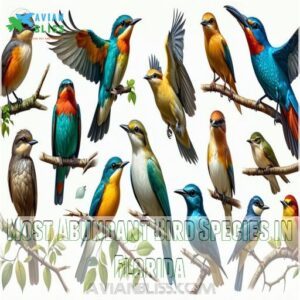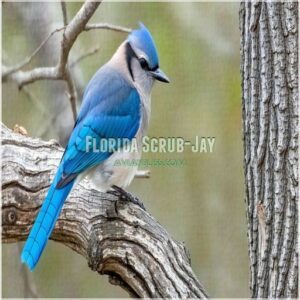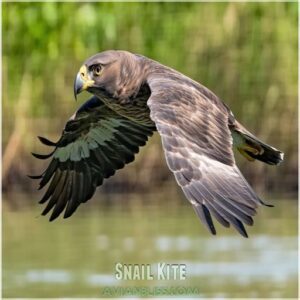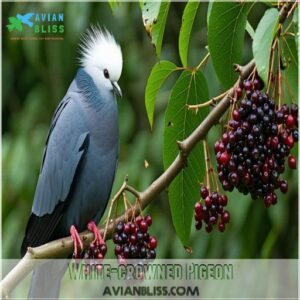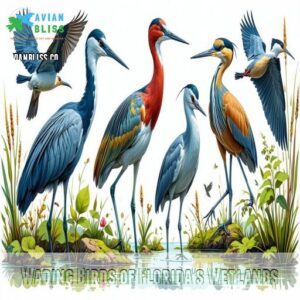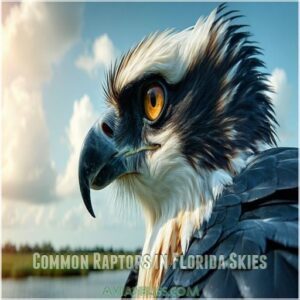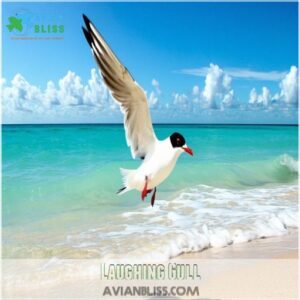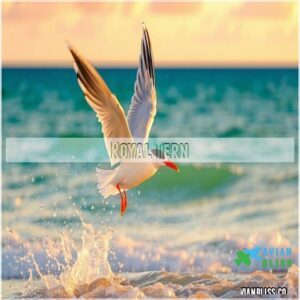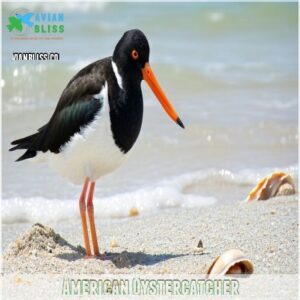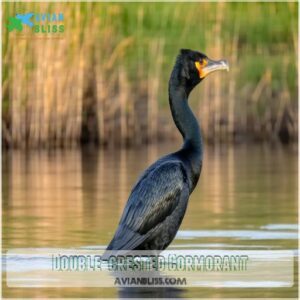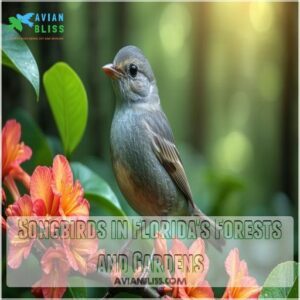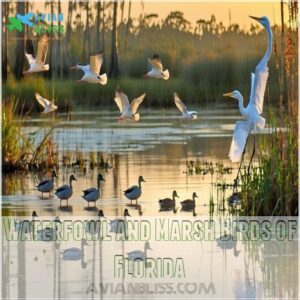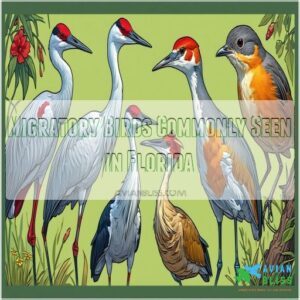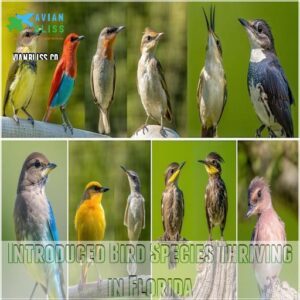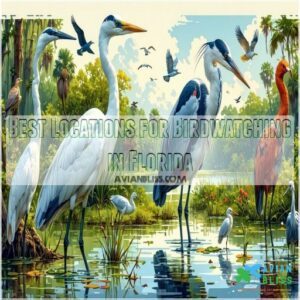This site is supported by our readers. We may earn a commission, at no cost to you, if you purchase through links.
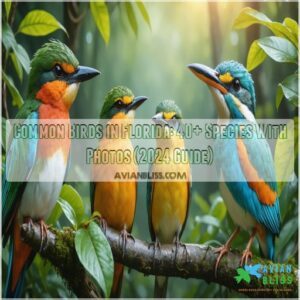
The Northern Cardinal, with its bright red plumage, is hard to miss, while the Blue Jay’s striking blue feathers and boisterous personality make it a backyard star.
You might hear the familiar coos of a Mourning Dove or catch a Northern Mockingbird imitating different bird calls.
Keep an eye out for Red-bellied Woodpeckers tapping away at trees too.
These feathered locals offer a glimpse into Florida’s vibrant avian community. Curious about their quirky behaviors or other species? There’s much more to discover!
Table Of Contents
- Key Takeaways
- Most Abundant Bird Species in Florida
- Florida’s Unique and Endemic Birds
- Wading Birds of Florida’s Wetlands
- Common Raptors in Florida Skies
- Coastal and Seabirds of Florida
- Songbirds in Florida’s Forests and Gardens
- Waterfowl and Marsh Birds of Florida
- Migratory Birds Commonly Seen in Florida
- Introduced Bird Species Thriving in Florida
- Best Locations for Birdwatching in Florida
- Frequently Asked Questions (FAQs)
- What is Florida’s most common bird?
- What is the small sparrow-like bird in Florida?
- What is the GREY bird in Florida with a red beak?
- What is the most common backyard bird?
- What bird is only found in Florida?
- What are the 4 foot tall birds in Florida?
- What are the birds that look like chickens in Florida?
- What is the most common bird of prey in Florida?
- What is the difference between a male and female cardinal?
- Do woodpeckers eat birdseed?
- Conclusion
Key Takeaways
- You’ll find a variety of common birds like the Northern Cardinal, Blue Jay, and Mourning Dove, which are easily spotted in Florida’s neighborhoods and backyards.
- Florida’s unique habitats make it home to endemic species such as the Florida Scrub-Jay, offering birdwatchers a chance to see birds they won’t find elsewhere.
- Wetlands and coastal areas boast vibrant wading and seabird populations, including the Great Blue Heron and Brown Pelican, perfect for birdwatching adventures.
- Migratory and introduced species, like the Ruby-throated Hummingbird and Monk Parakeet, add to Florida’s diverse birdlife, thriving in varied environments across the state.
Most Abundant Bird Species in Florida
When you’re birdwatching in Florida, you’ll often spot some of the state’s most abundant species like the vibrant Northern Cardinal or the chatty Blue Jay.
These common avians, including the graceful Mourning Dove and the clever Northern Mockingbird, bring a lively soundtrack to Florida’s diverse landscapes.
Florida birdwatching reveals abundant species.
Northern Cardinal
The Northern Cardinal is a standout among Florida birds.
Males flaunt their bright red, while females sport a classy olive-brown.
You’ll hear their cheerful "cheer-cheer-cheer" song from shrubs and trees.
Cardinals feast on seeds, fruits, and insects, making them flexible diners.
Keep an eye out in your backyard for these vibrant, common Florida birds, perfect for any bird enthusiast!
Mourning Dove
Mourning Doves are everywhere in Florida, from bustling city parks to peaceful backyards.
Visible with their soft gray feathers and iconic black wing spots, these birds are charming regulars of your morning routine.
Their "coo-AH, coo, coo, coo" call is soothing as they feast on seeds and grains.
Always fluttering around, they’re key players among common Florida birds. Always fluttering around. key players
Blue Jay
Ever seen a flash of brilliant blue in Florida? That’s likely a Blue Jay!
These clever birds boast vibrant blue feathers and loud calls, which include complex vocalizations and mimicry of hawk calls, showcasing their remarkable communication skills through various bird calls.
They’re omnivores, eating acorns, insects, and even small critters.
Blue Jays build messy cup nests in trees. Their "jay-jay" calls are unmistakable.
Spotting one? You’re witnessing a common Florida bird species!
Northern Mockingbird
Spotting the Northern Mockingbird in Florida is a treat for your ears as much as your eyes.
These talented mimics belt out a variety of sounds, often fooling even the keenest listeners.
Sporting gray plumage and standout white wing patches, they thrive in gardens and parks, munching on insects, berries, and the occasional lizard.
This flexibility makes them a charming resident across the state.
Red-bellied Woodpecker
Imagine this: a lively Red-bellied Woodpecker tapping away on a tree, its vibrant red crown making it a standout among the common birds in Florida.
These birds call wooded areas home but don’t be surprised if they visit your backyard feeder.
Their diet includes insects, nuts, and fruits.
Listen closely for their distinctive "churr" calls echoing through the trees.
Florida’s Unique and Endemic Birds
In Florida, you can spot some truly unique birds that make the state their exclusive home, like the charismatic Florida Scrub-Jay and the elusive Snail Kite.
These fascinating species adapt to Florida’s diverse habitats, offering birdwatchers a chance to see avian wonders they won’t find anywhere else.
Florida Scrub-Jay
Unique to Florida, the Florida Scrub-Jay thrives in sandy oak scrubs, relying on acorns.
These social birds live in family groups, helping raise siblings— a fascinating display of cooperative nesting behavior.
Unfortunately, habitat loss threatens their existence.
You might catch these blue beauties defending their turf, highlighting the need to protect these treasures among Florida’s native birds.
Snail Kite
Get ready to meet the Snail Kite, a bird with a taste for apple snails as unique as your craving for snacks at midnight!
This bird isn’t just picky; it’s an acrobat in the air, hovering like a helicopter.
Conservation efforts are giving it hope despite habitat loss.
Look for its curved beak and slate-gray or brown plumage.
Limpkin
Ever heard a bird scream like a banshee? That’s a Limpkin!
These Florida wetland natives are snail-eating experts. Their curved bills are perfect for cracking open apple snails.
Sadly, habitat loss threatens them. Help protect these amazing birds!
Their haunting calls are a Florida soundtrack. Learning about the Limpkin helps you appreciate Florida’s unique wildlife.
White-crowned Pigeon
Imagine this: the White-crowned Pigeon is the secret agent among Florida’s birds.
With its distinctive physical characteristics of the white crowned pigeon, this bird is a sight to behold.
If you’re exploring the southern coasts or the iconic Keys, keep an eye on the treetops for this sleek adventurer with its charming white cap.
They thrive on fruits from trees like poisonwood, though their survival is a delicate balance due to habitat loss.
Wading Birds of Florida’s Wetlands
When you explore Florida’s wetlands, you’ll find an incredible variety of wading birds, each adapted to life in marshes and swamps.
From the elegant Great Blue Heron to the striking Roseate Spoonbill, these birds offer fascinating glimpses into the rich biodiversity of the region. wading birds Florida’s wetlands
Great Blue Heron
Few birds embody elegance quite like the Great Blue Heron.
Standing in Florida’s wetlands, it’s a master of patience and precision, with a neck that seems to stretch forever.
You’ll find it fishing, neck arched, waiting for the perfect moment to spearfish with its bill.
These birds remind us that sometimes, the best results come to those who wait.
White Ibis
Amid Florida’s wetlands, the graceful White Ibis wades confidently, its elegant white feathers contrasting with striking red accents.
Watching them feed is like magic, as their curved red bills pluck delectable treats with precision.
Excellent parents, these social birds alternate nurturing duties, showcasing their adaptability by thriving equally in both wild marshes and urban locales. Your heart won’t resist their charm.
Roseate Spoonbill
You’ll fall for the Roseate Spoonbill, with its vibrant pink feathers and quirky spoon-shaped bill. These Florida natives strut in shallow waters, sweeping their bills for tasty crustaceans.
You’ll find them in mangroves and coastal marshes, thriving thanks to conservation.
- Nesting: Coastal mangroves and swamps
- Diet: Crustaceans and aquatic insects
- Threats: Habitat loss and pollution
Wood Stork
Spotting a Wood Stork in Florida’s wetlands is like meeting a relic from the past.
With its bald head and curved bill, this bird is part of nature’s cleanup crew, feasting on fish.
Despite facing habitat loss, conservation efforts are gaining ground.
Watch for their massive nests high in cypress trees—a true wonder among Florida’s native birds.
Snowy Egret
Imagine this: a Snowy Egret, all dazzling white, prancing on yellow feet.
These elegant birds hunt fish, using their toes to stir up the water. Their breeding plumage is a sight to see!
Learn about their diet, nesting habits, migration patterns, and the threats they face.
Snowy Egret conservation efforts are essential for these stunning Florida birds.
Common Raptors in Florida Skies
As you look up, Florida’s skies are graced by impressive raptors like the Osprey and Bald Eagle.
These birds showcase their strength and precision.
With keen eyesight and powerful wings, these birds play a vital role in maintaining ecological balance.
Osprey and Bald Eagle also capture the imagination of birdwatchers and nature enthusiasts alike.
Osprey
Ever wondered what it’s like to be a fishing pro? The osprey, one of Florida’s most impressive raptors, masters the art of hunting fish with precision. They’re adept at building colossal nests on poles or trees.
Want the best osprey experience?
- Spot them near water bodies.
- Observe their unique diet: fish-only menu.
- Watch out for their migration.
- Learn about their conservation.
Red-shouldered Hawk
Imagine a gliding guardian of Florida’s woodlands—the Red-shouldered Hawk.
With its rusty-red shoulders and barred chest, it’s both a scenic and symbolic bird of Florida.
Hanging out in wooded spots near water, it hunts small critters, builds high-up nests, and stays loyal to its patch through thick and thin.
Thanks to conservation, these hawks thrive, showcasing the success of protection efforts.
Bald Eagle
Spotting the Bald Eagle in Florida is like seeing a slice of freedom soar.
Being Florida’s sky kings, these majestic raptors proudly display white heads and tails, set against dark bodies.
Imagine nests as big as your bed, towering in tall trees.
Diet? Mostly fish, with a knack for spotting their meals from miles high.
Crested Caracara
Curious about the Crested Caracara?
This fascinating Florida bird sports a "toupee"-like crest, easily identified among common birds in Florida.
Found strutting through open fields, their diet includes carrion and small animals.
Known for their quirky habits, they stand out in the landscape of Florida birds.
While birdwatching, spotting a Caracara feels like a rare treat!
Black Vulture
Roaming Florida’s skies, Black Vultures are nature’s recyclers.
Their bald heads and short tails make them easy to spot in flight. They’re the social type, often roosting in groups and nesting in unlikely places like old buildings.
Their diet? Anything dead, helping keep ecosystems clean.
So, when you see their silhouettes overhead, you’re witnessing essential teamwork in nature.
Coastal and Seabirds of Florida
You’ll find Florida’s coastal areas teeming with diverse seabirds, from the iconic Brown Pelican with its distinctive pouch to the agile Royal Tern skillfully snatching fish from the waves.
This section profiles common species like the Laughing Gull, American Oystercatcher, and Double-crested Cormorant, highlighting their unique adaptations to the saltwater environment.
Brown Pelican
Brown Pelicans, the coast’s ancient gliders, captivate with their sudden plunges for fish.
These social creatures nest in bustling colonies, thriving in both salty and fresh waters.
Their flight is a marvel, effortlessly riding air currents with a pouch that’s always ready for action.
Witnessing them feels like stepping back in time, a proof of the marvels of Florida birdwatching.
Laughing Gull
The Laughing Gull, a coastal jester of Florida, captivates with its distinctive black head and red bill.
Recognized by their medium-gray back and wings, which provide camouflage against the ocean and sky.
Known for its humor-filled, laugh-like call, this gull isn’t picky about its meals, enjoying fish to fries.
Spot these lively characters along the shore and you’ll witness their playful behavior, a true delight for bird lovers exploring Florida’s avian wonders.
Royal Tern
When you’re exploring Florida’s beaches, keep an eye out for Royal Terns, and consider grabbing a pair of Royal Tern binoculars (https://zon.everysimply.com/Royal+Tern+binoculars/dp/) to get a closer look.
These feathered royals sport black crests and vibrant orange bills.
They’re quite the spectacle, swooping down to snatch fish from the water.
Found nesting in bustling colonies, their calls echo like a seaside chorus.
Understanding their migration and diet helps protect these enchanting coastal birds.
American Oystercatcher
Spotting an American Oystercatcher on Florida’s beaches is like finding a gem washed ashore! These charismatic birds flaunt their bright orange bills and black-and-white outfits. With a knack for cracking open oysters, they’re lively performers on the sand. Listen for their unique calls and enjoy their waddling antics—a delightful sight among common Florida birds.
- Vivid Colors: Bright orange bill and contrasting plumage.
- Diet Specialty: Primarily eats oysters and shellfish.
- Nesting Behavior: Prefers sandy beaches and marsh edges.
- Conservation Concerns: Habitat threats from coastal development.
- Chick Survival: Needs protection from predators and human activity.
Double-crested Cormorant
Double-crested Cormorants frequently grace Florida’s waterways, showcasing their sleek black physiques as they expertly dive for fish.
These adaptable birds aren’t fussy eaters, relishing any fish they snag.
Ever seen their wings spread wide, sunbathing? It’s quite the sight!
Despite past conflicts, their population thrives, making them a staple among the common birds of Florida.
Curious? Dive deeper into Florida bird identification.
Songbirds in Florida’s Forests and Gardens
As you wander through Florida’s forests and gardens, you’ll encounter a variety of songbirds like the cheerful Carolina Wren and the energetic Tufted Titmouse.
These lively birds add music to the landscape, making even a simple walk feel like a delightful concert just for you.
Carolina Wren
Frequently, you’ll encounter the Carolina Wren in Florida’s forests and gardens. This energetic bird boasts a distinctive upturned tail and a loud song. They’re adaptable, thriving in various habitats.
Their diet consists mainly of insects and spiders.
- Bold song
- Bushy tail
- Insect diet
- Backyard nests
Tufted Titmouse
The Tufted Titmouse in Florida is a tiny ball of energy with a punk rock mohawk.
These little guys love acrobatics and are unmistakable by their cheerful "peter-peter-peter" calls.
Attract them with sunflower seeds; they can’t resist!
You’ll find them zipping around Florida’s forests and gardens, making every birdwatching trip a joyful experience.
Northern Parula
You’ll be charmed by the Northern Parula’s cheerful song echoing through Florida’s forests. This tiny warbler, with its striking blue-gray back and yellow chest, is a lively performer among the treetops. Listen for its buzzy trill, a sure sign it’s nearby.
- Parula migration amazes with long journeys.
- Thrives in diverse habitats.
- Nesting high in mossy areas.
- Enjoys a bug-filled diet.
Blue-gray Gnatcatcher
If you’re exploring Florida’s forests and gardens, you might spot the tiny Blue-gray Gnatcatcher.
These lively acrobats flit through the trees, chasing insects with impressive agility.
They use their tails for balance and are often heard before they’re seen, thanks to their distinctive "spee" calls.
Look out for their cleverly camouflaged, lichen-covered nests – true masterpieces of nature!
Pine Warbler
Catch a glimpse of the Pine Warbler flitting through Florida’s pine forests.
These brightly hued yellow songbirds nestle high in tree canopies, feeding on insects and pine seeds.
Their cheerful, trilling songs fill the air, a delight during their migration north, though many stay year-round.
Spot their snug nests nestled in the pines—a true sight for bird enthusiasts!
Waterfowl and Marsh Birds of Florida
When you explore Florida’s wetlands, you’ll encounter a vibrant array of waterfowl and marsh birds like the Mottled Duck, Wood Duck, and Anhinga.
These fascinating birds thrive in the state’s unique ecosystems.
They glide through water and forage among reeds, creating an unforgettable birdwatching experience. This is a Florida wetlands adventure.
Mottled Duck
The Mottled Duck, a true Florida native, is a master of disguise with its blend-in brown feathers, thriving in the wetlands year-round.
To get a closer look or better identification, listening to their unique Mottled duck calls may be beneficial.
These ducks love shallow freshwater marshes and coastal prairies, munching on aquatic plants and small invertebrates.
So, next time you wander by a marsh, keep an eye out for these well-camouflaged wetland warriors.
Wood Duck
Among Florida’s waterfowl, you’ll find the striking Wood Duck.
These ducks prefer wooded swamps and rivers, making their home in tree cavities.
Males boast iridescent green heads and burgundy chests, while females have gray-brown heads and speckled brown chests.
Their diet consists of seeds, acorns, and insects.
Protecting their habitat is key to Wood Duck conservation efforts.
Common Gallinule
Picture yourself in Florida’s wetlands, where the Common Gallinule struts around, flaunting its red forehead shield and long, yellow-tipped toes.
These birds use their agile toes for balancing on lily pads and show off their swimming skills with chicken-like paddles.
With calls that sound like laughter, they’re the marsh’s lively residents, chattering about Gallinule life and survival.
American Coot
While enjoying the spectacle of waterfowl in Florida, you can’t miss the quirky American Coot.
With their chicken-like bodies and striking white bills, these common birds navigate freshwater habitats like experts.
They’re unique in their gregarious nature, often seen diving for aquatic plants or asserting themselves with small fish. Their adaptability makes them fascinating members of Florida’s bird life.
Anhinga
Spotting an Anhinga in Florida’s wetlands is like catching a nature show live.
These "snakebirds" glide with their unique S-shaped necks, showcasing their acrobatic skills. Known for swimming gracefully yet flying awkwardly, they delight in spearing fish with sharp beaks.
You’ll often see them drying wings, a necessity since their feathers aren’t waterproof.
Nests adorn nearby trees, facing threats like habitat loss and pollution.
Migratory Birds Commonly Seen in Florida
Every year, Florida becomes a temporary home for a variety of migratory birds, including the elegant Sandhill Crane and the lively Palm Warbler.
As they make their journey south, you can enjoy spotting these seasonal visitors fluttering through the state’s diverse habitats.
Palm Warbler
Palm Warblers, with their charming tail bobs, grace Florida during winter. These little brown beauties flaunt yellow undertails and favor open spaces with scattered trees. Keep an ear out for their high-pitched trill as they dart after insects. Check your backyard—they might be visiting your feeder!
- Migration: Winter visitors
- Habitat Preferences: Open areas with trees
- Diet: Insects and seeds
American Robin
As you wander Florida’s landscapes, the cheerful American Robin is a constant companion. These red-breasted thrushes enjoy a diverse diet—worms, insects, and juicy berries. Keep an ear out for their distinctive "cheerily, cheer up" song.
In spring, their well-crafted mud-cup nests appear in trees or on ledges, a hallmark of their resourcefulness and adaptability.
| Aspect | Description |
|---|---|
| Migration | Year-round residents in Florida |
| Nesting | Mud-cup nests in trees or buildings |
| Diet | Worms, insects, berries |
| Song | Cheerful "cheerily, cheer up" melody |
Ruby-throated Hummingbird
Ever seen a blur of emerald and ruby zip past? That’s a Ruby-throated Hummingbird!
These tiny dynamos migrate through Florida, their iridescent feathers flashing.
Attract them with hummingbird feeders and vibrant flowers, particularly favoring tubular flowers like trumpet vines Learn More About Ruby Throated Hummingbirds.
Learning about their nesting habits and migration patterns is key to appreciating these amazing Florida birds.
They’re tiny, but mighty!
Sandhill Crane
Spotting a Sandhill Crane is a treat, thanks to their long legs and vivid red foreheads.
During migration, these elegant cranes waltz into Florida’s wetlands and fields, delighting onlookers with lively courtship dances.
They nibble on plants and critters near marshes and grasslands.
Listen for their trumpeting calls, adding rhythm to the vibrant chorus of Florida birds.
Tree Swallow
From the graceful Sandhill Cranes, let’s look up to Tree Swallows. These dazzling flyers, sporting iridescent blue-green backs and pristine white underparts, swoop through Florida’s skies in mesmerizing aerial dances.
They’re famous for:
- Tree Swallow Nests in marshes
- Migration Patterns from Canada to Florida
- Diet Preferences: insects on the wing
- Conservation Status: stable
- Habitat Needs: near water
Watch them dart effortlessly, adding a sprinkle of magic to your birdwatching adventures!
Introduced Bird Species Thriving in Florida
Florida’s warm climate and diverse habitats have made it a welcoming home for many introduced bird species.
Many introduced bird species, like the vibrant Monk Parakeet and noisy European Starling, are thriving in Florida.
You’ll find these birds flourishing in urban areas, adapting cleverly to new environments alongside common natives.
Monk Parakeet
Imagine a splash of green amidst the cityscape—you’re looking at the monk parakeet, a lively resident of Florida’s urban jungles.
These resilient birds thrive in various habitats, favoring parks and busy streets.
Known for building intricate stick nests, they’re communal and chatty, enjoying seeds and fruits.
Intriguingly social, they blend seamlessly into the bustling life of Florida. These birds are a common sight.
European Starling
The European Starling is a familiar sight in Florida’s skies.
This small, shiny-black bird with a metallic glint is notorious for its raucous flocks and agricultural mischief.
A master of adaptation, it thrives on everything from seeds to scraps.
While efficient pest controllers, their aggressive nature often spells trouble for native species.
Love them or hate them, they’re here to stay.
House Sparrow
House sparrows, famous for their knack for adapting to human settings, are vivid examples of nature’s tenacity.
They thrive in urban jungles and rural landscapes, munching on everything from seeds to leftovers, and can even be supported with supplementary house sparrow food.
They group with others—living the social bird life.
Yet, they’re not without controversy, occasionally ruffling feathers among native bird species with their dominant ways.
Eurasian Collared-Dove
Sporting a distinctive black collar, the Eurasian Collared-Dove is a common sight in Florida.
These adaptable birds thrive in open areas, readily nesting and breeding. Their diet consists mainly of seeds and grains.
While their population is booming, understanding their impact on native doves remains essential for conservation efforts.
This introduced species highlights the complex dynamics of Florida’s avian ecosystem.
Muscovy Duck
Ever encountered a Muscovy Duck?
This hefty bird, with roots in Mexico, Central, and South America, thrives in Florida’s wetlands.
They don’t quack; they trill and hiss! They’re omnivores, munching on plants, insects, and small critters.
While not endangered, these ducks face threats from habitat loss. Conservation efforts focus on preserving wetlands and controlling pollution.
Best Locations for Birdwatching in Florida
You don’t want to miss the incredible birdwatching opportunities at Florida’s breathtaking spots.
From Corkscrew Swamp Sanctuary to the remote beauty of Dry Tortugas National Park, grab your binoculars and get ready for an unforgettable avian adventure.
Everglades National Park and Merritt Island National Wildlife Refuge are examples of these spots.
Everglades National Park
Head to Everglades National Park, a sanctuary for over 360 bird species.
This vast park is a hot spot for bird lovers and boasts a stunning array of birds, including the charming White Ibis and the rare Snail Kite.
Witness bustling flocks against the sunset and explore what makes this place a critical hub for conservation and bird migration.
Merritt Island National Wildlife Refuge
Nestled on Florida’s Atlantic coast, Merritt Island National Wildlife Refuge sprawls over 140,000 acres.
This birdwatcher’s heaven teems with diverse habitats—from saltwater marshes to pine flatwoods.
With over 330 bird species, it’s a hotspot along the Atlantic Flyway.
Visitors can enjoy hiking, birdwatching, or snapping pictures, soaking in its serene beauty and active habitat restoration efforts.
Corkscrew Swamp Sanctuary
Corkscrew Swamp Sanctuary, a nature wonder in southwest Florida, invites you with its 2.25-mile Corkscrew Swamp boardwalk.
Explore wildlife viewing, spotting the vivid Painted Bunting or endangered Wood Stork.
Perfect for bird photography and discovering the vibrant heart of swamp ecology in Florida’s beloved birding sites.
Ding Darling National Wildlife Refuge
J.N. "Ding" Darling National Wildlife Refuge on Sanibel Island is a paradise for Florida bird watching, offering over 245 bird species.
Start your adventure at the free Visitor and Education Center, then explore trails like Wildlife Drive.
Visit during low tide for the best Ding Darling photography.
Bring essentials like water, sunscreen, and bug spray to enhance your experience.
Dry Tortugas National Park
Ever dreamed of a birdwatching paradise?
Dry Tortugas National Park, 70 miles west of Key West, offers that. This remote park boasts incredible bird diversity, a key stopover for migratory birds, and is one of the many fantastic locations for spotting Florida’s diverse water birds.
Explore Fort Jefferson, a massive 19th-century fort.
Plan your trip carefully; it’s accessible only by boat or seaplane.
Enjoy the unique birds of Florida!
Frequently Asked Questions (FAQs)
What is Florida’s most common bird?
In the Sunshine State, the Northern Cardinal takes the crown as Florida’s most common bird.
With its vibrant plumage and cheerful song, it’s a favorite sight in your backyard.
thriving year-round in gardens and parks.
What is the small sparrow-like bird in Florida?
You might spot the Chipping Sparrow in Florida, a small, sparrow-like bird with a rusty cap and black eye-line.
These birds are common in open woodlands and backyards.
Often flitting around shrubs and trees.
What is the GREY bird in Florida with a red beak?
The Gray Catbird is a common sight in Florida.
Its sleek gray body and striking red under-tail coverts are easily recognizable.
Its name comes from its distinctive cat-like mewing call.
Making it a standout among backyard birds.
What is the most common backyard bird?
Imagine this: your backyard’s a feathered buffet!
Northern Cardinals frequently top the list as most common backyard birds in Florida.
They’re lively, readily visit feeders, and add a splash of red to your day.
What bird is only found in Florida?
Florida Scrub Jay calls Florida home, thriving in the scrubby flatwoods unique to the region.
Known for their vibrant blue plumage and social nature, they’re the only bird species endemic to the Sunshine State.
Florida Scrub Jay, symbolizing its natural beauty.
What are the 4 foot tall birds in Florida?
You might spot the towering Great Blue Herons or Wood Storks in Florida, both reaching about four feet tall.
These magnificent birds are easily recognized by their striking silhouettes and graceful movements.
wetlands and marshes.
What are the birds that look like chickens in Florida?
When you see a bird strutting like a chicken in Florida, it’s likely the Wild Turkey or the Northern Bobwhite.
These birds share a similar build and behavior,
often foraging the ground for food.
What is the most common bird of prey in Florida?
Ospreys are the most common bird of prey in Florida, known for their impressive fishing skills.
You’ll often spot them soaring along coastlines, rivers, and lakes, effortlessly diving to snatch fish from the water.
What is the difference between a male and female cardinal?
Imagine male cardinals as nature’s show-offs, flaunting vibrant red feathers that scream "look at me!"
In contrast, female cardinals boast a more understated elegance with soft tan plumage and subtle red accents.
Both are equally charming.
Do woodpeckers eat birdseed?
Woodpeckers can eat birdseed, especially when other food sources are scarce.
While they prefer insects and tree sap, offering suet or seed blends with nuts can attract them to your backyard feeders for a tasty treat.
Conclusion
Remember, "a bird in the hand is worth two in the bush," so keep your binoculars handy!
This guide has covered many common birds in Florida, from the vibrant Northern Cardinal to the stealthy Anhinga.
You’ve explored diverse habitats, learned about migratory patterns, and discovered unique species.
Identifying common birds in Florida enriches your understanding of the state’s rich biodiversity.
So, grab your field guide, head outside, and start exploring the amazing avian life all around you! Happy birding!

